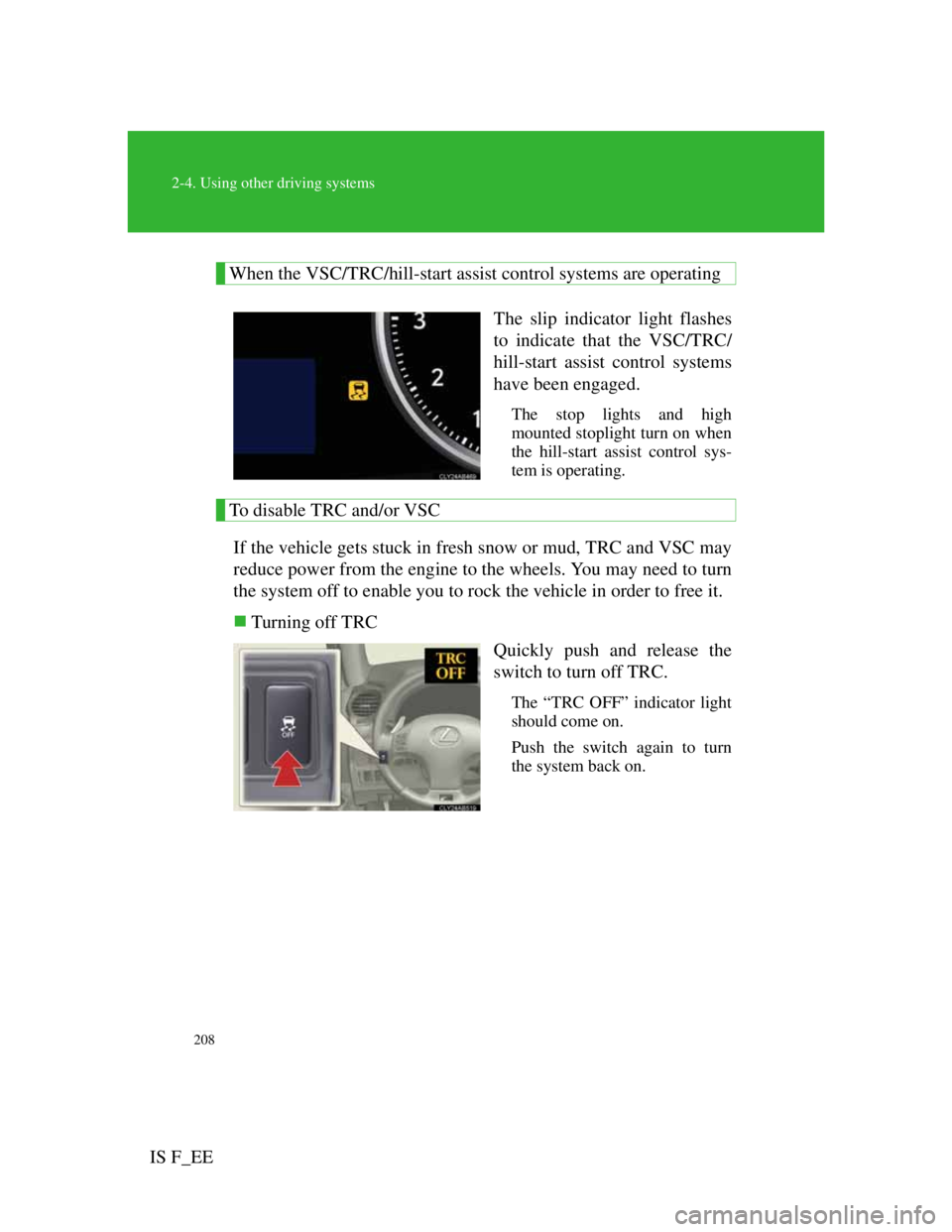Lexus IS F 2011 Owner's Manual
Manufacturer: LEXUS, Model Year: 2011,
Model line: IS F,
Model: Lexus IS F 2011
Pages: 529, PDF Size: 13.89 MB
Lexus IS F 2011 Owner's Manual
IS F 2011
Lexus
Lexus
https://www.carmanualsonline.info/img/36/29677/w960_29677-0.png
Lexus IS F 2011 Owner's Manual
Trending: navigation system, air suspension, brakes, bulb, odometer, ECU, tow
Page 211 of 529
200
2-4. Using other driving systems
IS F_EE
The distance display and buzzer
When a sensor detects an obstacle, the direction of and the approx-
imate distance to the obstacle are displayed and the buzzer sounds.
Front corner sensors
Multi-information
displayApproximate distance
to obstacleBuzzer
50 to 40 cm
(1.6 to 1.3 ft.)Medium
40 to 30 cm
(1.3 to 1.0 ft.)Fast
30 cm (1.0 ft.) or lessContinuous
Switching the Lexus parking assist-sensor on (P. 333)
When on, an indicator is dis-
played to inform the driver
that the function is opera-
tional.
Page 212 of 529
201
2-4. Using other driving systems
2
When driving
IS F_EERear corner sensors
Rear center sensors
Multi-information
displayApproximate distance
to obstacleBuzzer
50 to 37.5 cm
(1.6 to 1.2 ft.)Medium
37.5 to 25 cm
(1.2 to 0.8 ft.)Fast
25 cm (0.8 ft.) or lessContinuous
Multi-information
displayApproximate distance
to obstacleBuzzer
150 to 60 cm
(4.9 to 2.0 ft.)Slow
60 to 45 cm
(2.0 to 1.5 ft.)Medium
45 to 35 cm
(1.5 to 1.1 ft.)Fast
35 cm (1.1 ft.) or lessContinuous
Page 213 of 529
202
2-4. Using other driving systems
IS F_EE
Detection range of the sensors
Approximately 50 cm (1.6
ft.)
Approximately 150 cm (4.9
ft.)
The diagram shows the detec-
tion range of the sensors. Note
that the sensors cannot detect
obstacles that are extremely
close to the vehicle.
The range of the sensors may
change depending on the shape
of the object etc.
Page 214 of 529
203
2-4. Using other driving systems
2
When driving
IS F_EE
Page 215 of 529

204
2-4. Using other driving systems
IS F_EE
Sensor detection information
Certain vehicle conditions and the surrounding environment may affect
the ability of the sensor to correctly detect obstacles. Particular instances
where this may occur are listed below.
• There is dirt, snow or ice on the sensor.
• The sensor is frozen.
• The sensor is covered in any way.
• The vehicle is leaning considerably to one side.
• On an extremely bumpy road, on an incline, on gravel, or on grass
• The vicinity of the vehicle is noisy due to vehicle horns, motorcycle
engines, air brakes of large vehicles, or other loud noises producing
ultrasonic waves.
• There is another vehicle equipped with parking assist sensors in the
vicinity.
• The sensor is coated with a sheet of spray or heavy rain.
• The vehicle is equipped with a fender pole or wireless antenna.
• A towing eyelet is installed.
• The bumper or sensor receives a strong impact.
• The vehicle is approaching a tall or curved curb.
• In harsh sunlight or intense cold weather
In addition to the examples above, there are instances in which, because of
their shapes, signs and other objects may be judged by the sensor to be
closer than they are.
The shape of the obstacle may prevent the sensor from detecting it. Pay
particular attention to the following obstacles.
• Wires, fences, ropes etc.
• Cotton, snow and other materials that absorb radio waves
• Sharply-angled objects
•Low obstacles
• Tall obstacles with upper sections projecting outwards in the direction
of your vehicle
If the display flashes and a message is displayed
P. 4 3 1
Customization that can be configured at any authorized Lexus dealer or
repairer, or another duly qualified and equipped professional
Settings (e.g. buzzer volume) can be changed. (Customizable features P.
484)
Page 216 of 529
205
2-4. Using other driving systems
2
When driving
IS F_EE
CAUTION
Caution when using the Lexus parking assist-sensor
Observe the following precautions.
Failing to do so may result in the vehicle being unable to be driven safely
and possibly cause an accident.
Do not use the sensor at speeds in excess of 10 km/h (6 mph).
Do not attach any accessories within the sensor range.
NOTICE
Notes when washing the vehicle
Do not apply intensive bursts of water or steam to the sensor area.
Doing so may result in the sensor malfunctioning.
Page 217 of 529
206
2-4. Using other driving systems
IS F_EE
Driving assist systems
Page 218 of 529

207
2-4. Using other driving systems
2
When driving
IS F_EE
To help enhance driving safety and performance, the following sys-
tems operate automatically in response to various driving situations.
Be aware, however, that these systems are supplementary and should
not be relied upon too heavily when operating the vehicle.
ABS (Anti-lock Brake System)
Helps to prevent wheel lock when the brakes are applied suddenly,
or if the brakes are applied while driving on a slippery road surface.
Brake assist
Generates an increased level of braking force after the brake pedal
is depressed, when the system detects a panic stop situation.
VSC (Vehicle Stability Control)
Helps the driver to control skidding when swerving suddenly or
turning on slippery road surfaces.
TRC (Traction Control)
Maintains drive power and prevents the rear wheels from spinning
when starting the vehicle or accelerating on slippery roads.
Hill-start assist control
Helps to prevent the vehicle from rolling backward when starting
on an incline or slippery slope.
EPS (Electric Power Steering)
Employs an electric motor to reduce the amount of effort needed to
turn the steering wheel.
PCS (Pre-Crash Safety system) (if equipped)
P. 213
VDIM (Vehicle Dynamics Integrated Management)
Provides integrated control of the ABS, brake assist, TRC, VSC,
hill-start assist control, and EPS systems.
Helps to maintain vehicle stability when swerving on slippery road
surfaces by controlling the brakes, engine output and steering assist.
When the F-sport mode total control switch is pressed, “Sport”
mode is activated. (P. 209)
Page 219 of 529
208
2-4. Using other driving systems
IS F_EE
When the VSC/TRC/hill-start assist control systems are operating
The slip indicator light flashes
to indicate that the VSC/TRC/
hill-start assist control systems
have been engaged.
The stop lights and high
mounted stoplight turn on when
the hill-start assist control sys-
tem is operating.
To disable TRC and/or VSC
If the vehicle gets stuck in fresh snow or mud, TRC and VSC may
reduce power from the engine to the wheels. You may need to turn
the system off to enable you to rock the vehicle in order to free it.
Turning off TRC
Quickly push and release the
switch to turn off TRC.
The “TRC OFF” indicator light
should come on.
Push the switch again to turn
the system back on.
Page 220 of 529
209
2-4. Using other driving systems
2
When driving
IS F_EETurning off TRC and VSC
Push and hold the switch for 3
seconds or more to turn off
TRC and VSC.
The “TRC OFF” indicator light
and VSC off indicator light
should come on.
Push the switch again to turn
the system back on.
F-sport mode total control switch
Your vehicle is equipped with two types of control modes to
accommodate various driving preferences. The control modes can
be selected with the F-sport mode total control switch. Normal
mode allows secure and smooth normal driving. When the switch
is pressed, “Sport” mode is activated. Control characteristics such
as the ECT, EPS, VSC and TRC are adjusted to afford maneuver-
ability closer to what a driver may have imagined, while a sense of
security is retained.
“Sport” mode/Normal mode
The “SPORT” indicator comes
on when in “Sport” mode.
Trending: fuel consumption, buttons, service indicator, air conditioning, instrument panel, oil pressure, transmission fluid









